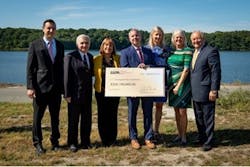WIFIA Program closes $269M loan to Narragansett Bay Commission
WASHINGTON, DC, SEPT 20, 2019 -- The U.S. Environmental Protection Agency (EPA) announced a Water Infrastructure Finance and Innovation Act (WIFIA) loan to the Narragansett Bay Commission (NBC) to help reduce pollutant discharges into Narragansett Bay. This project is the first WIFIA loan awarded in New England and will help protect public health and the ecosystems of the largest estuary in this region.
“This WIFIA loan will improve water quality in the Narragansett Bay, protect the health of local residents, and deliver on President Trump's commitment to upgrade our nation's infrastructure, create jobs, and safeguard public health and the environment,” said EPA Administrator Andrew Wheeler. “With this loan closing, EPA has now issued 12 WIFIA loans totaling over $3 billion in credit assistance to help finance over $7 billion for water infrastructure projects and create over 12,000 jobs.”
During heavy rain storms, combined sewer flows can exceed the capacity of the current system and overflow into local rivers and the Narragansett Bay. These overflows can carry pollutants- such as sewage solids, metals, oil, grease and bacteria- that can affect human health and the environment. EPA's WIFIA loan will provide approximately $269 million to help fund the Combined Sewer Overflow (CSO) Phase IIIA Facilities project. The project includes a long deep rock tunnel, two work shafts, four drop shafts, a tunnel pump station and several improvements to the wastewater collection system.
“EPA is very pleased that the first WIFIA loan award here in New England will result in cleaner and more healthy water in Narragansett Bay,” said EPA New England Regional Administrator Dennis Deziel. “In a major storm event, this Combined Sewer Overflow construction project will keep approximately 60 million gallons of water contaminated with raw sewage, metals, oil, grease and bacteria from being discharged directly into Narragansett Bay.
“We know Rhode Islanders value a clean and healthy bay. We’re very proud of infrastructure investments Narragansett Bay Commission ratepayers have made over the past two decades to mitigate the century-old issue of CSOs and the NBC is confident that this final phase of the CSO project will result in a bay that will be a beloved resource for our children and grandchildren,” said Narragansett Bay Commission Chairman Vincent Mesolella. “The WIFIA loan also ensures that the cost of this ambitious clean water project will be mitigated for our ratepayers.”
The Combined Sewer Overflow Phase IIIA Facilities project will cost $548 million. EPA's WIFIA loan will finance nearly half of that figure—up to $269 million. Additionally, the Rhode Island Infrastructure Bank (RIIB), through co-funding from the Rhode Island Clean Water State Revolving Fund (RI CWSRF) and other programs, will support a portion of the project costs. The RI CWSRF program is co-managed by the RIIB and the Rhode Island Department of Environmental Management. The WIFIA loan will save NBC an estimated $99.6 million compared to typical bond financing. Project construction and operation are expected to create 1,755 jobs.
The WIFIA loan closing was announced at an event hosted by the Narragansett Bay Commission at the Bucklin Point Wastewater Treatment Facility in East Providence, Rhode Island. Speakers included Narragansett Bay Commission Chairman Vincent Mesolella, U.S. Senator Jack Reed (RI), Rhode Island General Treasurer Seth Magaziner, Director of Rhode Island Department of Environmental Management Janet Coit and EPA Region 1 Administrator Dennis Deziel.
